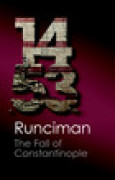
This classic account shows how the fall of Constantinople in May 1453 came as a bitter shock to Western Christendom. This classic account shows how the fall of Constantinople in May 1453, after a siege of several weeks, came as a bitter shock to Western Christendom. This classic account shows how the fall ofConstantinople in May 1453, after a siege of several weeks, came as a bitter shock to Western Christendom. This classic account shows how the fall of Constantinople in May 1453, after a siege of several weeks, came as a bitter shock to Western Christendom. The city's plight had been neglected and negligible help was sent in this crisis. To the Turks, victory not only brought a new imperial capital, but guaranteed that their empire would last. To the Greeks, the conquest meant the end of the civilisation of Byzantium and led to the exodus of scholars stimulating the tremendous expansion of Greek studies in the European Renaissance. INDICE: List of plates; List of figures; Preface; 1. The dying empire; 2. The rising sultanate; 3. The emperor and the sultan; 4. The price of Western aid; 5. Preparations for the siege; 6. The siege begins; 7. The loss of the Golden Horn; 8. Fading hope; 9. The last days of Byzantium; 10. The fall of Constantinople; 11. The fate of the vanquished; 12. Europe and the conqueror; 13. The survivors; Appendix I. Principal sources for a history of the fall of Constantinople; Appendix II. The churches of Constantinople after the conquest; Notes; Bibliography; Index.
- ISBN: 978-1-107-60469-8
- Editorial: Cambridge University
- Encuadernacion: Rústica
- Páginas: 270
- Fecha Publicación: 26/03/2012
- Nº Volúmenes: 1
- Idioma: Inglés
